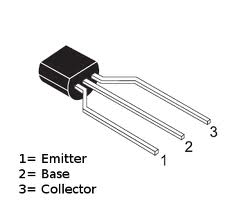

Black probe connected to base, and readings with the red probe connected to both emitter and collector ( one at the time ) => transistor is GOOD and is PNP.Red probe connected to base, and readings with the black probe connected to both emitter and collector ( one at the time ) => transistor is GOOD and is NPN.If I see it has the part number 2N3904 on it, I'll simply type that into Google (or any other search engine) and see what comes up. If you get readings, as in steps 1 and 2, but with the black probe connected to the base, and no readings at all with the red probe connected to the base, that means your transistor is also good, but is of PNP type. Answer (1 of 3): When I need to find the pinout of a part, I always look for writing on it. Step3: If you didn’t get readings at Step1 and 2, then move the black probe to base(B), and repeat Step1 and 2 ( You should NOT get any readings ( ∞Ω ) with the black probe connected to the base.
#Test transistor base emitter collector series
This is because resistors RB1 and RE as well as the base-emitter junction of the transistor are all effectively connected in series with the supply voltage, VCC. If you get readings ( higher then 0Ω ) in both cases, then the junctions are good, and because the red probe was connected to the base, means that the transistor is NPN type. This type of transistor biasing configuration, often called self-emitter biasing, uses both emitter and base-collector feedback to stabilize the collector current even further. Now we test the PN junction between the base and collector ( BC ).

Step2: Connect the red probe to the base(B) of the transistor and the black probe to the collector(E)

Negative lead to the transistor’s EMITTER (E). Transistor emitter with circuit emitter where (E) is marked. Connecting Base to the emitter Positive lead to the transistor’s BASE (B). It is important to put the transistor leads in the right direction. Now we test the PN junction between the base and emitter ( BE ). This same transistor when tested with my multimeter gave the following results. Step1: Connect the red probe to the base(B) of the transistor and the black probe to the emitter(E) Commonly, an NPN transistor will turn on every time there is a high signal, whereas the PNP transistor will turn on when there’s a low signal. On the other hand, a PNP transistor switches on without current flowing at the base terminal of the transistor. Note: You can use any type of ohmmeter ( analogical or digital ) The current drifts from the collector to the emitter terminal in an NPN transistor. Bipolar transistors come in two types, NPN and PNP, based on how the base of the transistor is doped.Ī simple method to see if the transistor is good ( presuming you have just an ohmmeter ), is to use the ohmmeter to test each of the two junctions.
#Test transistor base emitter collector how to
This post refers to how to test a bipolar junction transistor (BJT) with an ohmmeter.Ī bipolar transistor has two PN junctions a PN junction basically behaves as a simple diode.


 0 kommentar(er)
0 kommentar(er)
